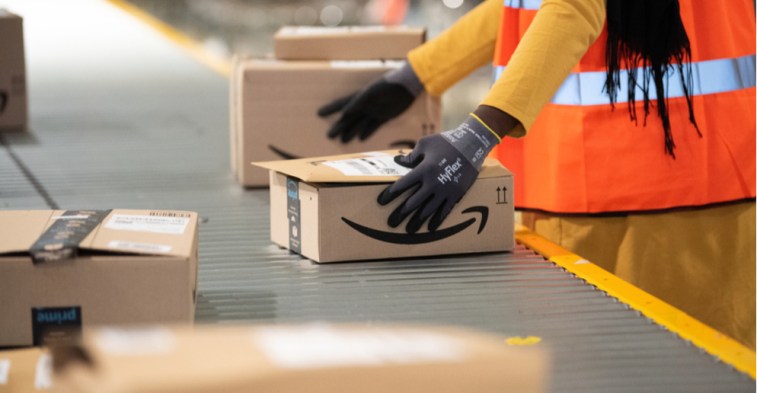New Fulfillment Frontier: Going the Last Mile in Package Management
We are moving into the traditionally high-volume shopping months—back-to-school, Black Friday, Cyber Monday, the holidays, and post-holiday sales. All this increased activity will be layered onto the already higher-than-ever levels of pandemic online shopping we have experienced for the last few months. According to the National Retail Federation, parents report plans for record-breaking back-to-school spending, with a particular emphasis on laptops, tablets, and headphones.
With more students and parents staying home, multifamily properties should take their package experience of the last six months and work to create a package management strategy that will carry them through the peaks of the next online shopping wave.
E-Commerce Grows Double Digits
Growth in e-commerce over the last few months isn’t a blip or even a spike. It is more like a Teutonic shift. Thanks to the shop-from-home impact of the Covid-19 pandemic, e-commerce is poised to grow 18 percent by the end of this year. There are more Internet shoppers than ever before, and those shoppers are buying more. That means more—many more—package deliveries to multi-family properties.
From Millennials and GenZ to Boomers, all generations are in the game. More than 75 percent of the American population has purchased goods online, ordering literally everything—from toothpaste and diapers to televisions and dishwashers—from an estimated 12 to 24 million e-commerce sites. This tsunami of brown boxes has forced managers and staffs of multifamily properties to become an essential part of the “last mile” of the e-commerce supply chain.
What Is “Last Mile” and How Does It Affect Property Managers?
In the shipping and delivery industry, last-mile traditionally refers to the final step in the delivery of a product from a warehouse to the customer. This final leg, which can range from just a few blocks to fifty or a hundred miles, is often the most costly and challenging segment in the entire logistics flow—especially as online customers have come to expect rapid-fire delivery—often same or next day.
Whether it be for security or logistical reason, national carriers such as UPS, FedEx, DHL, or USPS, deliver to a property’s designated receiving area; making the multifamily property staff the de facto last step of the last mile. Your team then has to log, notify, and deliver the avalanche of packages. They lift and carry, stack, stash, and store and are responsible for the safety and secure delivery to the correct recipient.
Think Like a Carrier
Managers of multifamily properties can take a cue from these national carriers. Here are three tips to help you develop a proactive package management strategy that prepares multifamily property staff to handle last-mile deliveries like the pros.
1. Assess Current Delivery Operations: The volume and variety of deliveries over the last six months has been a graduate course in delivery management. You and your teams already know much more about the impact of last-mile deliveries than you did a year ago. Take a moment to document the last six months of experience by gaining insights from all involved in the process:
-Residents: What aspects of delivery are your residents asking (or complaining) about? Typical priorities are security, convenience, 24/7 accessibility, and adequate receiving space. Since COVID, contactless solutions are at the top of the list. What else do your residents want?
-Staff: How are deliveries impacting your staff? Do you have enough temporary parking or are delivery trucks monopolizing the receiving dock or precious curbside front entrance? Are shelves and boxes ruining lobby ambiance? How are deliveries impacting efficiency or morale?
-Delivery Carriers: Reach out to the drivers and route managers at companies that deliver most frequently to your building—both national and local carriers. Talk to them about delivering to your property. Are other comparable properties on their routes handling deliveries differently? Do they have suggestions for your specific property?
2. Let the Data Drive: Go back to the basics to get ahead of this growing delivery tsunami. Work with your staff to create a process to identify, collect, and report the data you will need to make effective decisions about future package delivery. Here’s a get-started list:
Delivery
-Package types, sizes, weight
-Packages per delivery and per 24/hours
-Pickup and delivery times/frequency
-Carrier information – Amazon, UPS, USPS, FedEx, DHL, independent carriers
-Local delivery information – Dry Cleaners, Grocers, Food Delivery
-Odd- and over-sized deliveries (skis to TVs)
-Perishables
-Returns, waste management, and recycling
Building Logistics and Demographics
-# of units, average # of residents
-Elapsed time between delivery notification and resident pick-up
-Delivery path: docks and bays, driveways, pathways, controlled access to building
-Mail and package handling
External Data and Information Sources
-Industry associations (property management, retail, and others) for benchmarks, best practices, and trends. Example: NMHC or NAA
-Industry consultants, suppliers or vendors
-Managers of comparable properties
3. Technology: E-commerce delivery giants reinvented the delivery industry from the 1960s on with technology. FedEx revolutionized time-sensitive and urgent delivery. Decades before the iPhone, UPS drivers broke ground with hand-held tablets. Amazon Prime takes first place in warehouse automation. Now, these companies are testing sidewalk robots, drones, and driverless cars. On the residence side, leading-edge property managers can apply technology to the “last mile” with software, smart locker solutions and access-controlled package rooms that deliver convenient and secure 24/7 access for their residents.
Plan for the Future
For properties receiving packages, many days already feel like Black Friday and Cyber Monday all rolled into one. From forecasts and consumer behavior, we can only expect deliveries of all types to increase. By utilizing interviews, data collection, and adding technology, property managers can build an effective and flexible package management strategy that will continue to scale into the future.
__________________________________________________________________
Donna Logback is marketing director for Package Concierge®, the trusted provider of automated locker solutions for the modern world. By combining industry expertise and cutting-edge/leading technology, Package Concierge seamlessly automates package management for multifamily properties, student housing communities, retailers, and office buildings. As the only vertically integrated solution, Package Concierge® products are built in the USA and powered by proprietary software to deliver on security, design and functionality. With over 75 million package transactions, Package Concierge® collaborates with customers to address their evolving needs by optimizing operations and enhancing user experiences through its scalable smart locker solution. For more information, visit www.packageconcierge.com.





Leave a Reply